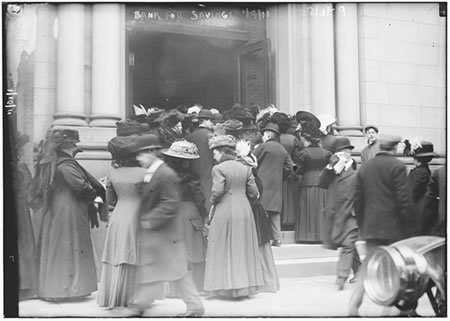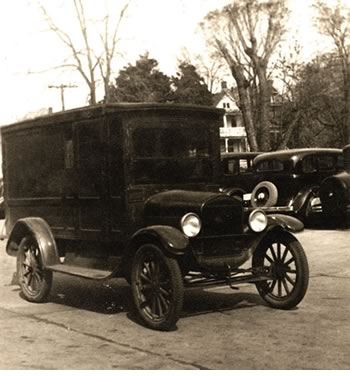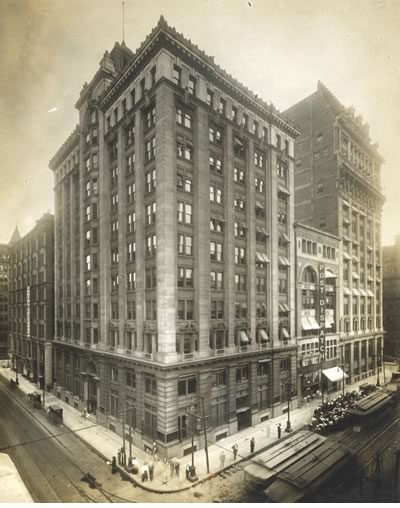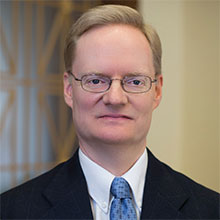The Fed is Born
The Idea of a Central Bank was Anathema to Many
In 1913, both houses of the U.S. Congress passed a bill that was sent to the desk of President Woodrow Wilson. He signed that bill into law Dec. 23 and set in motion the process of creating the Federal Reserve System. The president and the Congress did this in the face of some opposition, but they were propelled by a clear purpose and a strong commitment to confront disorder in the banking system. The Federal Reserve has since served this nation's economic interests for a century.
This year, the Federal Reserve Bank of St. Louis enters its second century in operation. The St. Louis Fed is one of 12 Federal Reserve banks established under the Federal Reserve Act of 1913. The act called for the establishment of at least eight, but not more than 12, Federal Reserve districts, each with its own Federal Reserve bank. The act also called for the establishment of a Federal Reserve Board, comprising government officials and located in Washington, D.C., to provide public oversight of the System. The act charged a Reserve Bank Organization Committee—consisting of the secretary of the Treasury, the secretary of agriculture and the comptroller of the currency—with drawing Federal Reserve district boundaries and selecting a city in each district for the headquarters of a Federal Reserve bank. The organization committee drew the boundaries of the Eighth Federal Reserve District to include the entire state of Arkansas and portions of Illinois, Indiana, Kentucky, Mississippi, Missouri and Tennessee, and selected St. Louis as the location for the District's Reserve bank. The Federal Reserve Bank of St. Louis received its charter May 18, 1914, and, along with the other 11 Reserve banks, opened for business Nov. 16, 1914.

Bank runs were not uncommon in the late 1800s and early 1900s when customers found out that banks were running out of currency. The Federal Reserve was created, in part, to deal with such shortages.
The Fed's principal responsibilities include the conduct of monetary policy, the supervision and regulation of key portions of the banking and payment systems, the provision of fiscal agency services for the U.S. Treasury, and the provision of payment services for depository institutions. The structure of the Federal Reserve System is uniquely American and reflects our nation's long tradition of balancing local, regional and national interests.
When Congress was deliberating the Federal Reserve Act, the idea of a central bank was anathema for most members of government, the business community and the general public. The central banks of European countries were private and secretive, and they served highly concentrated banking systems from national capitals. The Fed's proponents stressed that the Fed would not be a "central bank," but rather a confederation of regional Reserve banks that served their local community banks and citizens. Like all legislation, the Federal Reserve Act was a political balancing act, in this case between the interests of commercial banks and the general public, of large banks and small banks, and of Wall Street and Main Street.
First and foremost, the Federal Reserve was created to overcome some observed defects of the U.S. banking and monetary system that caused relatively frequent crises, known as banking panics. Panics were widely blamed on the "inelastic," or inflexible, supply of U.S. currency, which at the time consisted primarily of notes issued by national banks, and gold and silver coins minted by the U.S. government. Reformers also decried the concentration of the nation's bank reserves in a small number of banks in New York City and a few other cities, and the investment of those reserves in loans to stock market speculators.
The Federal Reserve Act created a new currency—the Federal Reserve note—and a means by which banks could quickly obtain additional currency from the Fed to satisfy any change in the demand for cash. The act also sought to end the geographic concentration of the nation's bank reserves and their diversion to the stock market.
The Federal Reserve Act called for the System's member banks, which included all banks with a federal charter, to hold their required reserves as balances with Federal Reserve banks. Previously, national banks could hold a portion of their required reserves in the form of correspondent balances with other national banks located in New York City, Chicago and St. Louis, which were designated as central reserve cities under Civil War-era banking acts.

In the early days of the St. Louis Fed, armored trucks, such as this Ford Model T, were used to shuttle cash between the Fed and commercial banks.
New York City banks held, by far, the largest volume of correspondent balances, and many of those balances were invested in short-term loans to stock market investors. Critics argued that this arrangement made the banking system vulnerable to Wall Street panics and drained the country's financial resources away from productive uses nationwide. Congress established a regional system of Fed banks and districts to reduce the concentration of bank reserves in New York City and other money centers and to encourage the productive use of the nation's banking resources throughout the country.
Whereas banking reformers expressly did not want to create a central bank dominated by large banks, let alone by Wall Street, there was also little support for a central bank that was merely an arm of the Treasury Department or under the direct control of politicians. Reformers understood that the power to print money was too great a temptation for governments to use to finance expenditures, which would invariably lead to inflation.
The result was a compromise. Under the Federal Reserve Act, the Federal Reserve banks are organized as private corporations. The stock of each bank is owned by its member banks. The members elect six of the bank's nine directors, who in turn select the bank's chief executive and chief operating officers. The Federal Reserve Board, however, is a government entity whose governors are appointed by the president of the United States and confirmed by the U.S. Senate. Under the Federal Reserve Act, the Board is charged with establishing regulations under which the Reserve banks operate, appointing three directors of each Reserve bank, approving the appointments of Reserve bank chief officers and providing general supervision of the Federal Reserve banks. The Federal Reserve Act was, thus, a carefully crafted law that sought to balance public and private interests, as well as to ensure a System that is responsive to all geographic regions of the country.
Over the years, there has been some rebalancing. In the wake of the Great Depression, Congress enacted the Banking Act of 1935, which reduced the autonomy of the individual Reserve banks and gave more authority to the Federal Reserve Board (which was then renamed the Board of Governors of the Federal Reserve System). The extent to which the Fed's structure contributed to the failures of the Great Depression remains debated, but the rebalancing of authority within the Fed reflected a general desire for a larger federal government response to the Depression. Nonetheless, Congress retained a substantial role for the Federal Reserve banks, both in determining monetary policy and in carrying out the supervisory and operating functions of the System. To a great extent, the regional structure set up by Congress has stood the test of time and continues to serve the nation well.
This book commemorates the 100-year history of the Federal Reserve Bank of St. Louis and the Federal Reserve System. We illustrate in these pages how the unique structure of the Federal Reserve System has served the nation well in the past and continues to be a strength of the System. We focus on contributions of the St. Louis Fed to show how the Federal Reserve and the nation benefit from the System's structure: Like the other 11 Reserve banks, the St. Louis Fed is responsive to local and national banking and economic conditions, fosters innovation, brings diverse views to bear in policymaking, and enables two-way communication between policymakers and the public.

The St. Louis Fed moved into this building on the southeast corner of Broadway and Olive Street in late 1915. The building (no longer there) had been called the National Bank of Commerce and was renamed the Federal Reserve Bank of St. Louis while the Bank was in occupancy.
In the 1970s, the St. Louis Fed became known as the maverick Reserve bank for its monetarist views about monetary policy. Our essay "Lessons from a Maverick" describes the debates within the System about the causes of inflation and the appropriate role of monetary policy in the economy. The St. Louis Fed lost the battle in the 1970s, but eventually won the war when the Fed, under Chairman Paul Volcker, brought inflation under control and accepted responsibility for maintaining price stability. The episode illustrates how the Fed's unusual structure promotes a competition of ideas that ensures that different perspectives are heard at the policymaking table.
The other essays in this book are both historical and current. We describe the selection of St. Louis as the home of one of the 12 Federal Reserve banks and the selection of Little Rock, Ark., Louisville, Ky., and Memphis, Tenn., as locations of our branch offices. We also develop our theme by describing the work of our Bank's functional areas and the important roles of our St. Louis and branch office boards of directors and advisory boards.



